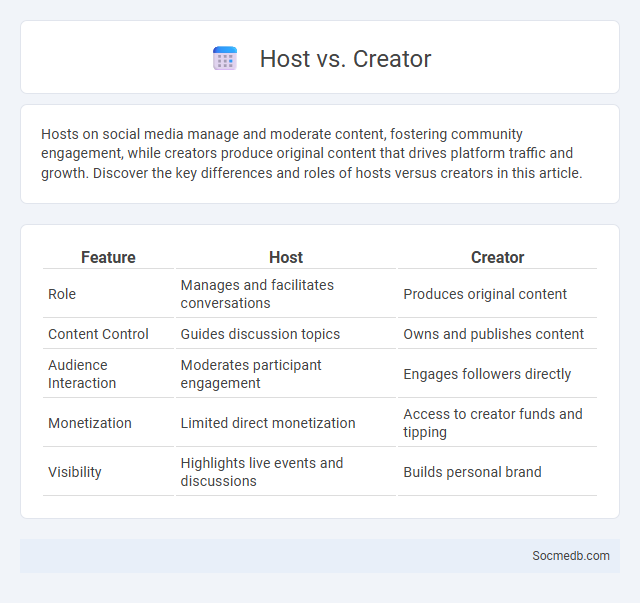
Photo illustration: Host vs Creator
Hosts on social media manage and moderate content, fostering community engagement, while creators produce original content that drives platform traffic and growth. Discover the key differences and roles of hosts versus creators in this article.
Table of Comparison
| Feature | Host | Creator |
|---|---|---|
| Role | Manages and facilitates conversations | Produces original content |
| Content Control | Guides discussion topics | Owns and publishes content |
| Audience Interaction | Moderates participant engagement | Engages followers directly |
| Monetization | Limited direct monetization | Access to creator funds and tipping |
| Visibility | Highlights live events and discussions | Builds personal brand |
Understanding the Roles: Host, Creator, and Spaces Host
Understanding the distinct roles of social media participants enhances effective engagement and content management. A host typically manages the overall platform environment, ensuring community guidelines and interactions align with platform standards. Creators produce original content that drives user engagement and platform growth, while spaces hosts facilitate live or interactive sessions, moderating discussions and fostering real-time community connections.
Defining a Host: Key Responsibilities
A host on social media manages live streams or virtual events, ensuring smooth interaction between content creators and viewers. Responsibilities include moderating comments, engaging the audience, and troubleshooting technical issues in real-time. Effective hosting boosts viewer retention and enhances overall user experience on platforms like Instagram Live, Facebook Live, and YouTube.
Who is a Creator? Scope and Functions
A creator on social media is an individual who produces original content such as videos, blogs, images, and podcasts tailored for online platforms like YouTube, Instagram, and TikTok. Their scope includes engaging audiences, building communities, influencing trends, and monetizing content through brand partnerships, advertisements, and fan support. Functions of a creator involve content strategy, audience interaction, analytics monitoring, and continuous adaptation to platform algorithms to maximize reach and impact.
Spaces Host Explained: Unique Features
Spaces Host on Twitter enables real-time audio conversations, allowing users to create and moderate live discussions with up to 13 participants, including hosts and speakers. Unique features include live transcription, ticketed Spaces for monetization, and the ability to invite co-hosts to manage sessions collaboratively. The platform integrates seamlessly with Twitter's ecosystem, enhancing audience engagement through retweets, direct replies, and hashtags during live audio events.
Skills and Traits: Host vs Creator vs Spaces Host
Social media professionals excel by developing distinct skills: Hosts master audience engagement and moderation in live formats, prioritizing real-time interaction and community management. Creators focus on content production, showcasing creativity, storytelling, and visual design to attract and retain followers. Spaces Hosts specialize in audio-based social interactions, requiring excellent verbal communication, spontaneous conversation skills, and the ability to foster inclusive dialogue in virtual rooms.
Content Control and Ownership Differences
Social media platforms differ significantly in content control and ownership policies, impacting how Your data and posts are managed. Some platforms grant users full ownership of their content, while others retain rights to use or distribute posts without additional permission. Understanding these distinctions is crucial for maintaining control over Your digital footprint and ensuring the protection of Your intellectual property.
Audience Engagement: Comparing Approaches
Audience engagement on social media varies significantly between platforms, with video content generating 120% more interactions than text-based posts. Your choice of content format, whether stories, reels, or static images, directly influences user interaction rates and retention time. Prioritizing personalized responses and timely comments can boost engagement by up to 40%, demonstrating the importance of active communication in growing your online community.
Monetization Opportunities for Each Role
Content creators can monetize their social media presence through brand partnerships, sponsored posts, and affiliate marketing, maximizing earnings by leveraging their niche audience. Influencers benefit from exclusive collaborations, merchandise sales, and paid subscriptions, turning follower engagement into significant revenue streams. Your strategic use of platform-specific features like YouTube Super Chats, Instagram Shopping, or TikTok Creator Fund enhances monetization tailored to your unique role.
Choosing the Right Role for Your Brand
Choosing the right role for your brand on social media focuses on aligning your identity with your audience's expectations and platform strengths. Understanding the unique features of platforms like Instagram for visual storytelling or LinkedIn for professional networking enables targeted engagement. You maximize your brand's impact when your social media role reflects your core values and resonates authentically with your audience.
Future Trends: Host, Creator, and Spaces Host Evolution
Future trends in social media highlight the evolving roles of hosts, creators, and spaces hosts, emphasizing immersive experiences and interactive content. Platforms are increasingly integrating virtual and augmented reality to enhance engagement, enabling creators to design dynamic environments that amplify user participation. You can expect these innovations to transform content delivery, making social media spaces more personalized and community-driven.
 socmedb.com
socmedb.com